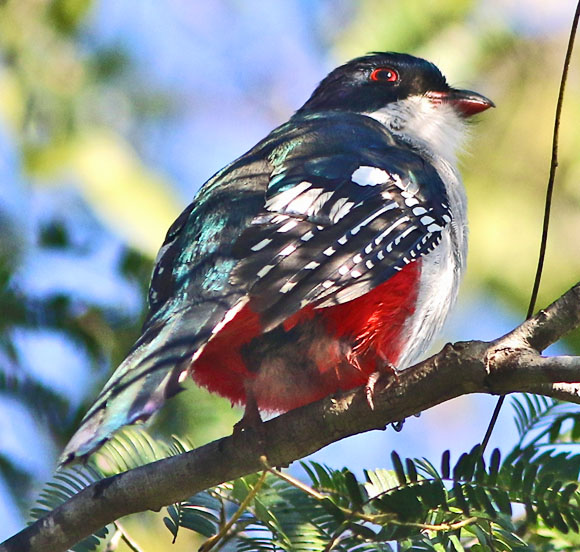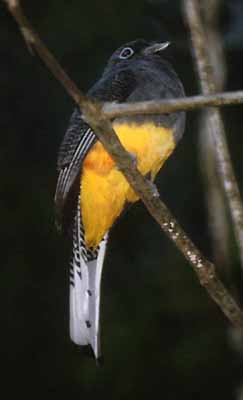
a web page by Don Roberson |
TROGONS Trogonidae |
||||
|
||||
Surucua Trogon (male, left) is one of those Brazilian trogons. It is almost entirely restricted to rainforests in southeastern Brazil but ranges into Paraguay and northern Argentina. However, the phylogenetic relationships of trogons is no longer obscure. The most comprehensive genetic data (Jarvis et al. 2014, Prum et al. 2015) place trogons in their own Order. The Trogoniformes are now sequenced among a group of orders that consists of the Coraciiformes, Piciformes, Bucerotiformes, and Upupiformes. Some genetic data (Moyle 2005) suggest that the quetzals might be basal to all other trogons, including Old World genera. Beyond that it appears the African trogons (genus Apaloderma) are the earliest branch and the next split is between the Asian trogons and the New World trogons (e.g., Prum et al. 2015). |
||||
|
||||
|
||||
|
||||
Trogons are birds of the forest, ranging from humid lowlands to mountain cloud forests. Although splendidly colored, they are much easier to hear than to see. Their hollow hoots have a ventriloquial quality, and it can be very hard to locate a perched bird until it moves. That it true of Elegant Trogon (right), a Mexican species that reaches southeastern Arizona and thus is the only regularly breeding trogon in the United States. It tends to be the highlight of an Arizona trip for American birdwatchers. Trogons live in pairs or solitarily, scanning the foliage for caterpillars and other largish arthropods, snatching these prey from leaves or limbs by hovering. At other times they fly-catch with short sallies, or visit fruiting trees. The bill is broad and surrounded by bristles (recalling nightjars). The neck is short and the eyes large, with eyelids and eyelashes. |
||||
|
||||
But the bulk of the family is in the New World. With 20 species, almost half of the family Trogonidae is in the familiar Neotropical genus Trogon. As example is this west Mexican thorn-forest endemic Citreoline Trogon (male, left). Trogons in this genus are either citrus-bellied (lemon or orange) or red-bellied. Citreoline is obviously a yellow-bellied species. Strangely enough, an uncropped version of this slide, with lots of surrounding habitat, appeared in Vol. 6 of Handbook of the Birds of the World (Collar 2001). Plus there are the quetzals! Eared Quetzal Euptilotis neoxenus is a real prize. Not only is it lovely and rare, but it has loud, raucous, memorably and totally un-trogon-like calls — all of which we got to experience when we chased a vagrant in southeast Arizona back in August 1991. The most spectacular of the New World trogons are the five species of quetzal (genus Pharomachrus) and the most famous is the Resplendent Quetzal (shown near the top of this page) of Central America. The male has one of the longest tails – actually modified uppertail coverts — in the world. It is a sedate bird of "damp, epiphyte-laden mountain forests, frequenting canopy and edges" (Stiles & Skutch 1989). Resplendent Quetzal was considered sacred to the Mayans and Aztecs, and is now found on the Guatemalan coat-of-arms and flag. |
||||
Many species of trogons nest in abandoned termite mounds — some typically create their own burrows — or holes in rotting dead trees or thick tree-fern trunks. When we found a nest hole of Resplendent Quetzal atop El Triunfo volcano, Chiapas, Mexico, most of the time we could only see the long tail streamers sticking out of the hole. Can you "count" a quetzal if you only see long uppertail coverts? Fortunately we were around for a week, and saw the entire bird! When I first posted a page on Trogonidae in 1999, there were then 39 generally-accepted species in the World. Now there are 43, and three of those involve recent splits in South American species. The Amazon Basin, various foothill forests, and the Andes are all now stocked with additional but elusive trogons to be located. Below is a pair (male on left) of Masked Trogon from the Peruvian cloud forest at Owlet Lodge. |
||||
 |
||||
Photos: The male Surucua Trogon Trogon surrucura was at Itiatia NP, southeastern Brazil, on 6 Aug 2010. The Cuban Trogon Priotelus temnurus was at Babiney, Cuba, on 8 Feb 2017. The male Resplendent Quetzal Pharomachrus mocinno was at Savegre Mountain Lodge, Costa Rica, on 23 Dec 2007. David Bishop photographed the male Ward's Trogon Harpactes wardi in April 1994 along Lingmethang Road, Bhutan. Paul Huang photographed the male Whitehead's Trogon Harpactes whiteheadi on Mt. Kinabalu, Sabah, Malaysia, in the early 2000s. The male Elegant Trogon Trogon elegans was at Ramsey Canyon, Arizona, USA, on 30 Apr 2018. The female White-tailed Trogon Trogon viridis was was along Pipeline Road, Canal Zone, Panama, in Jan 1981. The male Orange-breasted Trogon Harpactes oreskios at Kaeng Krachan NP, Thailand, on 21 Dec 2012. The male Citreoline Trogon T. citreolus was at San Blas, Nayarit, Mexico, on 26 Feb 1987. The pair of Masked Trogon T. personatus was along a cloud forest trail at Owlet Lodge, Amazonas, Peru, on 21 Nov 2014. All photos © Don Roberson, except those credited to © David Bishop and/or © Paul Huang, and used with permission; all rights reserved. Paul Huang has a web site with many fine shots from Borneo and elsewhere. Bibliographic note: There is a book some years ago (2000) by Paul Johnsgard on the Trogons and Quetzals of the World but I have not seen it. The family is now well-covered by Collar (2001) in the Handbook of the Birds of the World series. That family account includes some stunning photos of quetzals. Murray Lord points out that John Gould's (1838) A Monograph of the Trogonidae is available is some fine book stores for about $45,000. Good to know. Literature cited:
|
 In 1993, Helmut Sick wrote in The Birds of Brazil that "the trogons are a small group with splendid plumage, worthy of symbolizing the exuberance of the tropics. Well represented in the Neotropics (especially in Central America), they also occur in Africa and the Oriental region, although in reduced diversity. Their appearance is distinctive, and their phylogenetic relationships are obscure."
In 1993, Helmut Sick wrote in The Birds of Brazil that "the trogons are a small group with splendid plumage, worthy of symbolizing the exuberance of the tropics. Well represented in the Neotropics (especially in Central America), they also occur in Africa and the Oriental region, although in reduced diversity. Their appearance is distinctive, and their phylogenetic relationships are obscure."






 The Old World trogons (3 in Africa, 12 in Asia) seem inordinately difficult to see in dense primary forest — e.g., we spent an hour before we caught a glimpse a calling Bare-cheeked Trogon Apaloderma aequatoriale in Gabon. When trogons are found, I have been impressed by the beauty of the those in Borneo, the Philippines, and Bhutan.
The Old World trogons (3 in Africa, 12 in Asia) seem inordinately difficult to see in dense primary forest — e.g., we spent an hour before we caught a glimpse a calling Bare-cheeked Trogon Apaloderma aequatoriale in Gabon. When trogons are found, I have been impressed by the beauty of the those in Borneo, the Philippines, and Bhutan.